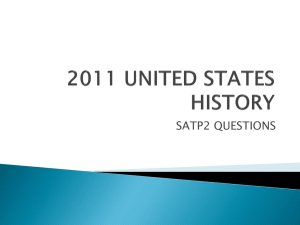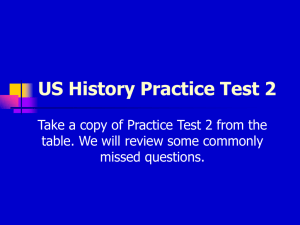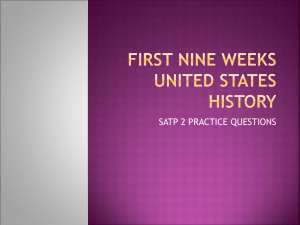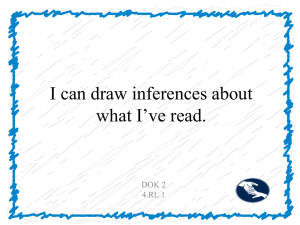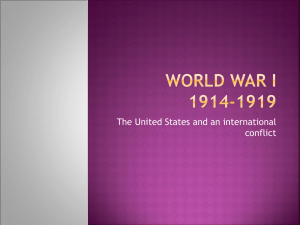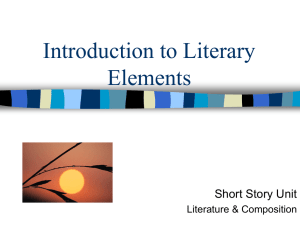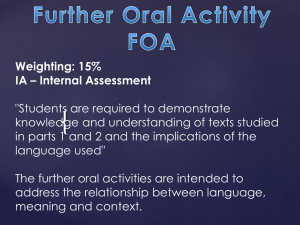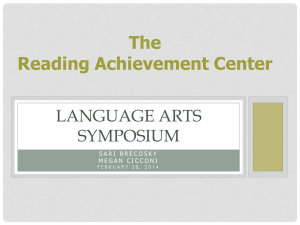Fifth Grade I Can Posters Border
advertisement
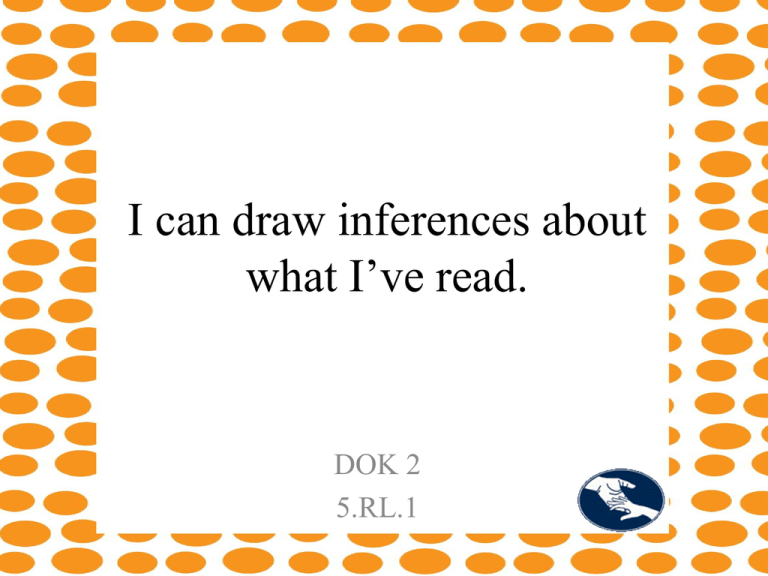
I can draw inferences about what I’ve read. DOK 2 5.RL.1 I can quote from the text. DOK 1 5.RL.1 I can support my answers drawn from the text using quotes. DOK 3 5.RL.1 I can summarize the text. DOK 2 5.RL.2 I can identify the theme of a story, drama or poem. DOK 2 5.RL.2 I can analyze text to find how the character’s traits and actions determine the theme. DOK 3 5.RL.2 I can compare two or more characters, settings, or events in a story or drama. DOK 2 5.RL.3 I can contrast two or more characters, settings, or events in a story or drama. DOK 2 5.RL.3 I can support my comparisons with specific details from the text. DOK 3 5.RL.3 I can identify metaphors and similes in a text. DOK 1 5.RL.4 I can analyze (break apart) the meaning of figurative language when used in a text. DOK 3 5.RL.4 I can use context clues to determine the meaning of unknown words. DOK 2 5.RL.4 I can describe the structure of a story, drama, or poem. DOK 2 5.RL.5 I can explain how specific parts of the reading relate to each other as a whole. DOK 3 5.RL.5 I can infer the narrator’s or speaker’s point of view in a text. DOK 2 5.RL.6 I can make and support generalizations of the narrator’s or speaker’s point of view. DOK 3 5.RL.6 I can analyze and evaluate how the narrator’s or speaker’s point of view influences how the events are described in the text. DOK 4 5.RL.6 I can recognize and describe how the elements of visual and multimedia presentations contribute to the text. DOK 2 5.RL.7 I can explain and support how the elements of visual and multimedia presentations enhance my understanding and appreciation of the text. DOK 3 4 5.RL.7 I can identify characteristics of the same genre. DOK 1 5.RL.9 I can determine themes and topics of a text. DOK 1 5.RL.9 I can compare and contrast themes and topics within a genre. DOK 2 5.RL.9 I can read stories at my grade level. DOK 1 5.RL.10 I can recognize main idea in grade level texts. DOK 2 5.RL.10 I can make inferences while reading grade level texts. DOK 3 5.RL.10 I can draw inferences about what I’ve read. DOK 2 5.RI.1 I can support my inferences with quotes from the text. DOK 3 5.RI.1 I can support my answers drawn from the text using quotes. DOK 3 5.RI.1 I can locate specific information in a text. DOK 1 5.RI.1 I can summarize the text. DOK 2 5.RI.2 I can connect several main ideas and the supporting details. DOK 3 5.RI.2 I can explain how two or more specific events, ideas, concepts, or individuals are connected. DOK 3 5.RI.3 I can explain what happened and why using specific events, ideas, and concepts from the text. DOK 2 5.RI.3 I can identify the relationships between two or more individuals, events, ideas, or concepts. DOK 1 5.RI.3 I can use context clues to analyze (break apart) unknown words and phrases. DOK 1 5.RI.4 I can use graphic sources to analyze an unknown word or phrase. DOK 3 5.RI.4 I can determine the correct meaning of words with more than one meaning. DOK 2 5.RI.4 I can identify text structures in informational text. DOK 2 5.RI.5 I can compare and contrast text structures in two or more informational texts. DOK 3 5.RI.5 I can connect overall text structure between two or more texts. DOK 4 5.RI.5 I can describe how authors’ points of view influence how the events are described in the text. DOK 2 5.RI.6 I can compare and contrast multiple accounts of the same event or topic. DOK 3, 4 5.RI.6 I can evaluate the most effective source to find an answer or solve a problem quickly. DOK 3 5.RI.7 I can effectively use reference materials and the computer to answer questions or solve a problem. DOK 1 5.RI.7 I can use text features and different types of text to find information. DOK 2 5.RI.7 I can explain how an author uses reasons and evidence to support their points in a text. DOK 3 5.RI.8 I can identify which reasons and evidence support which point(s). DOK 2 5.RI.8 I can analyze a text to evaluate an author’s reasons and evidence. DOK 4 5.RI.8 I can apply information from several texts to increase my understanding of a subject. DOK 3 5.RI.9 I can explain my synthesis of several texts through writing or speaking. DOK 4 5.RI.9 I can determine and recognize the main idea of texts. DOK 2 5.RI.9 I can read informational text at my grade level. DOK 1 5.RI.10 I can determine the main idea of informational text at my grade level. DOK 2 5.RI.10 I can use root words and affixes to determine the meaning of unknown words. DOK 1 5.RE.3 I can read with purpose and understanding. DOK 1 5.RE.4a I can read on-level poetry out loud with accuracy, appropriate rate, and expression after practicing. DOK 1 5.RE.4b I can self correct my reading if needed. DOK 5.RE.4c I can include my opinion with the introduction of the topic when writing an argument. DOK 2 5.W.1 I can organize my ideas when writing an argument. DOK 2 5.W.1a I can write a full composition demonstrating synthesis of opinions and reasons. DOK 4 5.W.1b I can link opinion and reasons when writing an argument. DOK 3 5.W.1c I can write a concluding statement or paragraph to support my opinion when writing an argument. DOK 2 5.W.1d I can state an informational topic clearly and provide a general observation and focus. DOK 2 5.W.2 I can organize information into paragraphs and sections. DOK 2 5.W.2a I can include informational text features and multimedia to help my reader better understand my message. DOK 2 5.W.2a I can write a full composition demonstrating synthesis of information and details. DOK 3 5.W.2b I can link ideas when writing an informational piece using words, phrases, and clauses. DOK 2 5.W.2c I can use topic specific language and vocabulary to better inform my reader. DOK 2 5.W.2d I can write a concluding statement or paragraph to support my topic when writing an informational piece. DOK 4 5.W.2e I can introduce my reader to the topic by clearly identifying the characters, setting, plot, narrator, sensory details, and sequence of events. DOK 2 5.W.3 I can write a full composition demonstrating complex ideas. DOK 4 5.W.3 I can describe experiences and events through character dialogue to help my reader understand better. DOK 2 5.W.a I can support ideas using details and elaboration. DOK 3 5.W.3b I can describe experiences and events through pacing to help my reader understand better. DOK 2 5.W.3b I can use a variety of transitional words, phrases, and clause to organize the sequence of events. DOK 2 5.W.3c I can use specific words or phrase and sensory details to describe experiences and events in narrative writing. DOK 2 5.W.3d I can write a clear conclusion when writing a narrative piece. DOK 2 5.W.3e I can produce clear, organized writing, or many types, that includes appropriate task, purpose, and audience. DOK 3 5.W.4 I can write a full composition using varied sentence types and structures. DOK 4 5.W.4 I can brainstorm ideas related to a topic. DOK 1 5.W.5 I can organize my writing in a logical sequence. DOK 2 5.W.5 I can edit my final draft for mechanics and conventions. DOK 2 5.W.5 I can edit my final draft for meaning and progression and ideas. DOK 3 5.W.5 I can analyze and evaluate my writing. DOK 4 5.W.5 I can, with help from adults, use technology to produce and publish my writing. DOK 2 5.W.6 I can, with help from adults, use technology to communicate with others. DOK 1 5.W.6 I can type a minimum of two pages in one sitting. DOK 1 5.W.6 I can research and investigate a topic using several sources to gain knowledge and understanding. DOK 3 5.W.7 I can synthesize information from multiple sources. DOK 4 5.W.7 I can recall and gather important information from print and digital sources. DOK 1 5.W.8 I can summarize and paraphrase information in notes and finished work. DOK 2 5.W.8 I can list the sources that I used. DOK 1 5.W.8 I can gather information from literary or informational texts to support my ideas. DOK 2 5.W.9 I can analyze literary or informational texts. DOK 3 5.W.9 I can write for extended periods of time for many tasks, purposes, and audiences. DOK 2 5.W.10 I can apply a concept in new contexts. DOK 3 5.W.10 I can write a full composition demonstrating complex ideas for a specific purpose and audience. DOK 4 5.W.10 I can come prepared to discuss a topic with required materials. DOK 2 5.SL.1a I can follow rules for discussion. DOK 1 5.SL.1b I can ask and respond to specific questions based on others’ remarks. DOK 3 5.SL.1c I can summarize and draw conclusions of a discussion. DOK 4 5.SL.1d I can summarize a text read aloud or presented in different forms, such as visual media. DOK 2 5.SL.2 I can connect ideas using supporting evidence. DOK 3 5.SL.2 I can summarize the points a speaker makes in a presentation. DOK 2 5.SL.3 I can explain the claim using reasons and evidence. DOK 3 5.SL.3 I can formulate an opinion based on facts and details. DOK 2 5.SL.4 I can speak clearly and at an understandable pace. DOK 1 5.SL.4 I can present my opinion logically and sequentially. DOK 3 5.SL.4 I can use multimedia components and visual displays in presentations to support my main idea. DOK 2 5.SL.5 I can evaluate the effectiveness of a multimedia component in a presentation. DOK 3 5.SL.5 I can use formal English when needed. DOK 1 5.SL.6 I can evaluate appropriate speech depending on context. DOK 2 5.L.1 I can explain the function of conjunctions, prepositions, and interjections. DOK 1 5.L.1a I can use the perfect verb tenses correctly. DOK 1 5.L.1b I can use verb tense correctly to show times, sequences, states, and conditions. DOK 5.L.1c I can identify and correct misuse of verb tenses. DOK 2 5.L.1d I can use correlative conjunctions like either/or and neither/nor correctly. DOK 1 5.L.1e I can separate items in a series with correct punctuation. DOK 1 5.L.2a I can use a comma to separate the introductory element from the rest of the sentence. DOK 1 5.L.2b I can use a comma to set off the words yes and no, to set off a tag question from the rest of the sentence, and to indicate direct address. DOK 1 5.L.2c I can use underlining, italics, or quotation marks to show the title of works. DOK 1 5.L.2d I can spell grade-level words correctly and use reference materials as needed. DOK 1 5.L.2e I can expand, combine, and reduce sentences for meaning, reader/listener interest, and style. DOK 3 5.L.3 I can compare and contrast the varieties of English used in stories, dramas, or poems. DOK 2 5.L.3 I can evaluate a sentence to determine the correct meaning for multiplemeaning words. DOK 2 5.L.4 I can use context clues to determine the meaning of unknown words and phrases. DOK 1 5.L.4a I can use common affixes and roots as clues to the meaning of an unknown word. DOK 1 5.L.4b I can use reference materials to find the pronunciation and/or meaning of words or phrases. DOK 3 5.L.4c I can understand the meaning of figurative language, such as similes and metaphors. DOK 2 5.L.5a I can identify and explain the meaning of common idioms, adages, and proverbs. DOK 3 5.L.5b I can use the relationship between particular words, such as synonyms, antonyms, and homographs, to better understand each of the words. DOK 1 5.L.5c I can learn and use gradelevel words and phrases. DOK 1 5.L.6 I can demonstrate relationships between ideas using grade-level and domain-specific words and phrases. DOK 2 5.L.6
